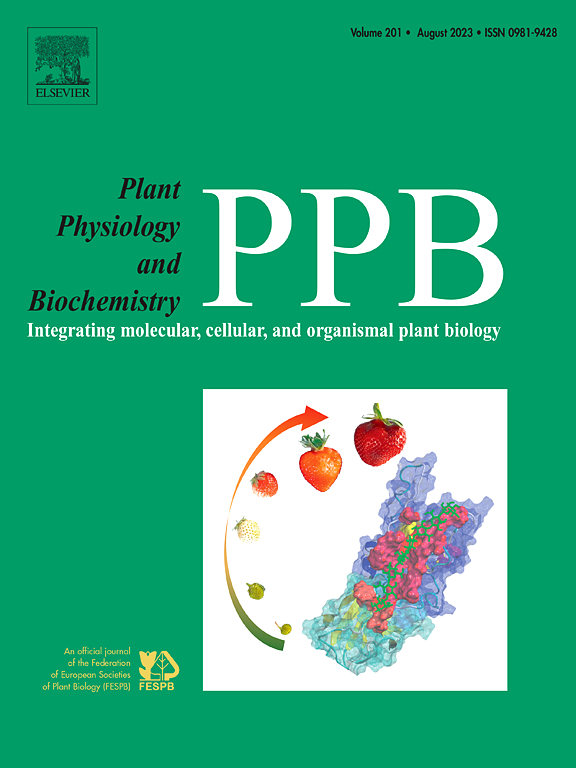秋水仙碱和稻谷素诱导的六倍体提高了韭菜的营养水平,是一种很有前途的种质资源
IF 6.1
2区 生物学
Q1 PLANT SCIENCES
引用次数: 0
摘要
韭菜主要通过无融合繁殖,这极大地限制了杂交育种的努力。以萌发的三倍体韭菜种子为材料,用秋水仙碱和米草苷诱导染色体加倍。比较了三倍体和六倍体韭菜的生长习性和几种次生代谢产物的分析。结果表明,秋水仙碱和谷胱甘肽均能使幼苗根和子叶变短变厚,且谷胱甘碱处理的幼苗存活率高于秋水仙碱处理的幼苗。六倍体叶片纤维素含量比三倍体叶片低约7.6%,而可溶性糖、总黄酮、维生素C、可溶性蛋白和风味化合物含量分别比三倍体叶片高110.5%、27.3%、10.2%、8.9%和2.2%。本研究结果表明,米杂灵是一种有效的诱导韭菜染色体加倍的化学剂,诱导的六倍体具有较大的食用价值。本文章由计算机程序翻译,如有差异,请以英文原文为准。
Colchicine- and oryzalin-induced hexaploidy enhances nutrient levels and is a promising way to create new germplasms for Chinese chives
Chinese chives reproduce primarily through apomixis, which greatly limits hybrid breeding efforts. Herein, germinated triploid Chinese chive seeds were used as the materials, and colchicine and oryzalin were applied to induce chromosome doubling. Observations of the growth habits and analysis of several secondary metabolites were compared between triploid and hexaploid Chinese chives. Results indicated that both colchicine and oryzalin can cause shortening and thickening of the young roots and cotyledons, with a greater survival rate observed in seedlings treated with oryzalin than in those treated with colchicine. The leaf cellulose content in hexaploid seedlings was approximately 7.6 % lower than that in the leaves of triploid seedlings, while the soluble sugar, total flavonoid, vitamin C, soluble protein, and flavour compound contents increased by 110.5 %, 27.3 %, 10.2 %, 8.9 %, and 2.2 %, respectively. Our findings suggest that oryzalin is an effective chemical agent for inducing chromosome doubling in Chinese chives and that the induced hexaploid possesses greater edible value.
求助全文
通过发布文献求助,成功后即可免费获取论文全文。
去求助
来源期刊
CiteScore
11.10
自引率
3.10%
发文量
410
审稿时长
33 days
期刊介绍:
Plant Physiology and Biochemistry publishes original theoretical, experimental and technical contributions in the various fields of plant physiology (biochemistry, physiology, structure, genetics, plant-microbe interactions, etc.) at diverse levels of integration (molecular, subcellular, cellular, organ, whole plant, environmental). Opinions expressed in the journal are the sole responsibility of the authors and publication does not imply the editors'' agreement.
Manuscripts describing molecular-genetic and/or gene expression data that are not integrated with biochemical analysis and/or actual measurements of plant physiological processes are not suitable for PPB. Also "Omics" studies (transcriptomics, proteomics, metabolomics, etc.) reporting descriptive analysis without an element of functional validation assays, will not be considered. Similarly, applied agronomic or phytochemical studies that generate no new, fundamental insights in plant physiological and/or biochemical processes are not suitable for publication in PPB.
Plant Physiology and Biochemistry publishes several types of articles: Reviews, Papers and Short Papers. Articles for Reviews are either invited by the editor or proposed by the authors for the editor''s prior agreement. Reviews should not exceed 40 typewritten pages and Short Papers no more than approximately 8 typewritten pages. The fundamental character of Plant Physiology and Biochemistry remains that of a journal for original results.

 求助内容:
求助内容: 应助结果提醒方式:
应助结果提醒方式:


